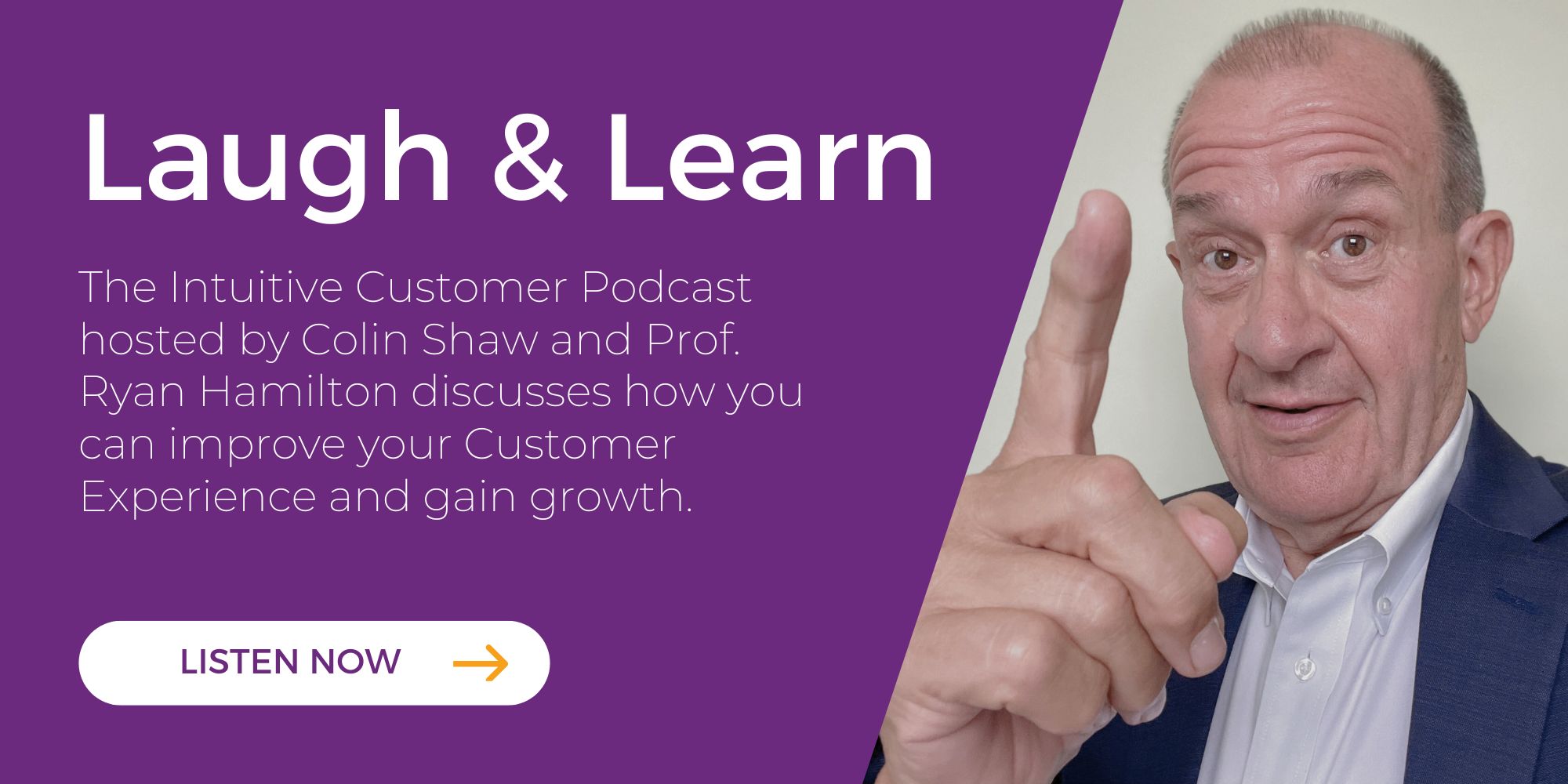Learn more about Colin Shaw: Join over 85,000 people on our LinkedIn Newsletter list or visit our website for more great podcast episodes.
Listen to the podcast:
One of our podcast listeners has a pickle. Claire Dunwood wrote to us to say she felt that her customers’ expectations consistently rise, and managing them is challenging in that she now has fewer resources to devote to them. I figured some of you had this problem, too, so today, I wanted to share some of what we recommended.
Before I get into the recommendations, discussing how we develop expectations would probably be a good idea. Usually, with clients and in workshops, I use the following exercise:
Close your eyes and imagine you have just landed in the Congo. After deboarding the plane, you pass through the arrivals area and move outside. What does it look like? How is the weather? What are the other people wearing? How do you feel?
No matter what you pictured or how you answered, these are your expectations. When forming expectations, we often draw from adjacent or similar experiences.
Without previous experience to draw from, these images you had could have come from TV programs you have seen, novels you read (or heard about), or social media clips from other people’s trip to the Congo, among others. You might even have expectations that you form based on memories of a similar trip to Africa to a different country. Pulling in information from these other sources allows you to create an expectation, even for completely novel experiences.

We All Compare Experience to Expectation
All of us have called into a company, bracing for a poor experience. However, sometimes the experience we have with a call center isn’t half bad. Maybe the call center picked up the call quickly, and then, instead of an automatic menu, gave us a live person who seems to anticipate what we need even before we need it. When we hang up, we probably say, “Well, that wasn’t what I expected!”
Customers have experiences and compare them to their expectations all the time. So, even if they have never interacted with you before, they have expectations about how that will go before the interaction starts. Afterward, customers remember what happened and compare it to what they thought would happen. If you are lucky, you are better than what they expected.
One of the things Dunwood said is that customer expectations are always rising. If you feel the same about your customers, determine which part of the expectation is rising.
Expectations fall under three categories: rational, emotional, and sensory. Rational expectations are the fundamentals of the interaction, like product, price, and performance. Emotional expectations will be when customers interpret the company values, business, satisfaction, and how that feels. Sensory expectations will include whether they could hear or see when they needed to or how it felt to interact with the company.

For Dunwood and anyone else responding to rising customer expectations, I advise determining what part of the expectation is rising and why. Then, decide if this area will be a focus for your organization. For my part, I would only focus on the area if it drives value for customers.
Therefore, I would have anyone responding to rising customer expectations ask themselves:
- What part of the expectations—rational, emotional, or sensory—is rising?
- Which part drives enough value for customers that you should allocate the most resources to meet those expectations?
- Where are your customers pulling their expectations from for comparison? Is it competitors or experiences in another part of their lives?
For example, Amazon did an amazing job of designing its e-commerce experience. People understand and use the site across all customer segments. Amazon raised customer expectations for all e-commerce sites by making the site easy to use. So, if Dunwood sells widgets on an e-commerce site to customers who shopped on Amazon, their expectations are likely to be quite high regarding an ease-of-use perspective.

5 Ways to Manage Customers’ Expectations
Now that we have covered where expectations might come from, let’s look at five ways to manage customer expectations.
- Understand customers’ needs and what their expectations are. Remember, asking about expectations and needs is important, but it is also essential to watch customer behavior to find the hidden needs and expectations.
- Engage in proactive communication. This step is essential. Telling customers how you are working to address these needs and expectations.
- Employ transparency to set clear boundaries. Make sure customers understand what you will and won’t do.
- Be consistent. When you do what you say you will repeatedly, it clarifies realistic expectations and builds customer trust.
- Leverage technology. This one speaks to the reduced resources part of Dunwood’s pickle. It is essential to use the functionalities of technology to meet customer’s rising expectations.
There are some caveats here. For example, when implementing your technology, remember which aspects of the expectations and experience are most valuable to your customers.
A key insight from the book Blue Ocean Strategy is to do whatever is important to your customers better than anybody and let go of everything else. You don’t need to be great at everything, only the important things to your customer.
However, what is important to one customer might not be to another. That’s why it is essential to know your customers and to which segment they belong. You could implement technology to save money but unwittingly destroy the Customer Experience, at least for some segments.
Once you know your customers, it might also be wise to ask yourself whether they are the right ones for you. In other words, if you determine the rising expectations of your customers are making them too expensive for you to profit from, it might be time to lose those customers. Don’t waste any more resources trying to improve the experience to meet their unprofitable expectation needs.
By contrast, knowing your customers will probably also reveal a group driving profit for you. The expectations and demands of this group should be your priority.
Perhaps it is helpful to think of it as listening and adapting to your customers’ key segment. By staying agile, you can adapt to your strengths. However, you should ensure that these adaptations are based upon solid customer feedback from reliable sources, whether surveys, social media, or CRM (customer relationship management) systems input.
Remember also that there are occasions when you could change your customer’s expectations or influence them. For example, the hamburger chain Five Guys in the US does this brilliantly with French fries. They have a medium and a large size. Each size comes in a cup that corresponds to the size of the fries ordered. Once they have filled the cup with fries, they put it in the bag with your hamburger and then shovel a couple more scoops of fries on top. By doing this, Five Guys can set your expectations about how many fries to expect based on the size you ordered and then exceed that expectation in the same transaction.

To Summarize: Know Thy Customers and Know Thy Technology
When it comes to managing customers’ expectations, it all comes down to how well you know your customers. If you know them well enough, you know what they expect and how you can meet or exceed those expectations. You will also see if they expect too much and whether you want to continue to have them as a customer.
Regarding diminishing resources, there are a few things one can do to respond to rising expectations. First, you can leverage technology where possible to pick up some slack. For now, that might be limited to communication automation, but those capabilities might expand with artificial intelligence. Second, you can focus on what drives the most value for customers and your organization.
Prioritizing these areas is essential, particularly when you can’t respond to every demand. Responding to customers’ rising expectations is essential, but prioritizing what response you focus on first can save your sanity and budget in today’s economic climate.
Do you have a pickle (aka, business problem) that you want my podcast partner and me to solve? We would be glad to listen, so tell us about it by clicking here. Your pickle could be the focus of our next podcast.

This review sums it up: “The dynamic between the two hosts absolutely makes this podcast. Each brings a unique take on the topic, their own perspective, and plays off each other’s sense of humor. I come away after each episode with a feeling of joy and feeling a bit smarter”.
Listen to the podcast: https://beyondphilosophy.com/podcasts


